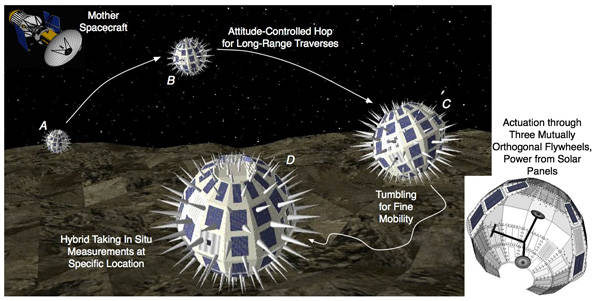This article is more than 1 year old
Leaping hedgehog probes planned for Martian moon Phobos
Spiky systems use flywheels for low-gravity scouting
Researchers at Stanford University and NASA are designing spiky spherical probes to bounce across the Martian moon Phobos and prepare the way for possible astronaut colonization.
The plan calls for an orbital control satellite, a coffee table–sized unit dubbed Phobos Surveyor, which would scan the moon's surface using gamma ray or neutron detectors to get an idea of the surface composition. It would then fire the "hedgehogs" down onto the Phobian surface, where their prongs would sample the soil.
Given the tiny amount of gravity on the moon's surface, wheels would be useless to get around, so the probes are controlled by tri-directional flywheels. These could force the probe to either roll, hop, or bound longer distances across the surface, depending on the rotation speed of individual flywheels.
"You can get into very hard rocky terrain, or very soft, almost like powder, terrain," said doctoral candidate Ross Allen. "Whatever's touching the ground needs to get traction on hard stuff without getting stuck on soft stuff."
Over a two or three year mission, the Phobos Surveyor could gather a full sample spectrum of the moon's surface and relay it back to Earth. Scientists could jump the probes to new survey spots chosen by the Surveyor's scans and sample specific areas of the heavily cratered moon.

Hedgehogs in spaaaace!
"It's the next level of autonomy in space," said the probe's designer, Marco Pavone, an assistant professor in Stanford's Department of Aeronautics and Astronautics.
While the technique would be suitable for other low-gravity environments like asteroids and comets, Phobos is the suggested first target. This is partially to work out what the moon actually is, and also to map it out for a possible manned base.
Phobos is rather unusual as Solar System moons go – it orbits closer to the surface of its host planet than any other moon and is so dark as to be difficult to spot at times. It's suspected the moon is a captured rubble-pile asteroid, with a third of its volume made up of hollow spaces, but Pavone suggested the moon has a key advantage as a base for human exploration of Mars.
With no gravity well to speak of, Phobos would be safer and cheaper to land humans on, and the closeness to the surface is an advantage for controlling exploration vehicles remotely. There may also be considerable quantities of water on the moon that could provide resources for a base, but this needs to be checked.
"It's a piece of technology that's needed before any more expensive type of exploration is considered," Pavone said. "Before sampling we need to know where to land. We need to deploy rovers to acquire info about the surface."
So far, two generations of prototypes have been built and tested in simulated low-gravity environments to check the flywheel transport system. A third-generation system is due to be put through its paces next summer, including testing the probe's mobility in actual zero-gravity using swooping aircraft, although presumably without the spikes.
The final system could be ready in ten years, but if the team gets moving they might hitch a ride with Curiosity v2.0 at the end of the decade. A full paper on the project will be presented at the Institute of Electrical and Electronics Engineers Aerospace Conference in March. ®
